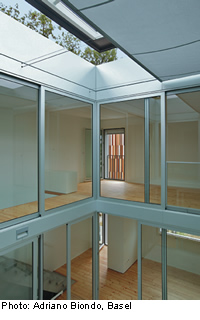Housin Development in Allschwil

Situated on the edge of the old village centre of Allschwil in Switzerland, these two blocks of terraced houses were laid out at an angle to each other. One group comprises five units with a floor area of 135 m2 each; the other contains four houses 158m2 in area. The staggered facade heights reflect the topography of the slightly sloping site. A large communal landscaped space was created instead of the usual private gardens. In each of the houses, however, there is a 15m2, two-storey-high patio, glazed on three sides and with a glass roof. These spaces serve to articulate and illuminate the 16.45-metre-deep dwellings. The party walls, the walls flanking the sanitary cells, and the patio columns are the only load-bearing elements, which allows maximum flexibility in the layout. The houses were erected to the so-called “minergy-P” standard (see page ??). When closed, the specially constructed glass roofs over the patios contribute to passive-energy gains. In summer, the roofs can be opened and act as a means of cooling. To achieve an optimum balance between thermal storage mass and insulation, the architects chose a mixed form of construction, with solid floors, roofs and party walls; and highly insulated, prefabricated two-storey timber facade elements. The energy for heating and for the hot-water supply comes mainly from the solar installation. A gas-fired combined heating and power unit in the basement of block 1 can also be switched on if required. The ventilation system regulates the fresh-air and heating supplies via wall and floor inlets in the living spaces. Vitiated air is sucked out through the soffits over the sanitary cells. Fresh air can be preheated (or cooled) by 2–3°C by means of an earth grid. Some 90 per cent of the residual energy in the vitiated air is extracted by a heat-recovery system and fed back to warm the intake of fresh air. In view of the minimal thermal energy needed for heating, the fresh-air supply can be warmed to room temperature if required by a device attached to the hot-water installation. It was thus possible to do without a conventional heating system.
